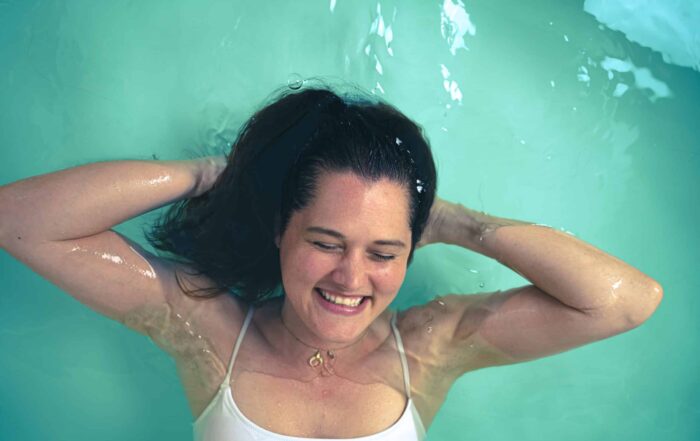Whether it’s recovering from physical ailments, soreness and fatigue, or recovering from mental strain, stress, or anxiety, floating for just 60 minutes can have a dramatic effect on all.
Because of this, wellness professionals, athletes, the handicapped, and regular people alike have turned to float therapy to improve their overall health and quality of life. Over the past several years, float therapy has gained mainstream popularity.
Let’s take a look at just some of the reasons why floating is gaining so much popularity over the years.
benefits of float therapy

1. FLOATING IS COMMON AMONG ATHLETES AND CELEBRITIES
How often do you get to feel like you are weightless? If you are reading this from the International Space Station, then the joke is on us, but for everyone else, there just aren’t many options.
When you utilize float therapy, the effects of gravity on your body are muted. As a result, your body is allowed to completely relax, whereby allowing your blood vessels to expand more freely and deliver greater blood flow to all parts of your body.
Greater blood flow allows your body to remove toxins and a greater rate, along with it lactic acid crystallized in between muscle fibers. After just 60 minutes of floating weightless you feel rejuvenated and totally relaxed.
Floating in a stress-free, weightless environment with little sensory stimuli causes a release in endorphins which produce a positive, euphoric feeling of well-being and happiness. As you become accustomed to the effect of floating, your mind can even adapt to release endorphins at the simple thought of floating!
Because of all the powerful effects with floating, professional athletes have turned to float therapy to gain a competitive edge for years (1).
In fact, floating is such an important recovery tool the New England Patriots’ Quarterback Tom Brady (2) had a custom float tank installed in his house! During the week leading up to Super Bowl XLIX, players from both the Seattle Seahawks and the New England Patriots booked one float center’s entire appointment book.

2. FLOATING IS A POWERFUL FORM OF THERAPY AND RELIEF
While many seasoned floaters use float therapy to aid their performance, recovery, and meditation habits, the majority of floaters will benefit simply from the state of relaxation that comes with floating in a sensory deprivation tank. In our busy modern culture, we struggle to find consistent ways to deal with stress, which is the leading cause of employee absenteeism, illness, mental disease and death.
People with fibromyalgia are in constant pain–there are only rare occasions where their whole body does not ache. Thankfully, studies have shown that floating is one of the occasions where sufferers of fibromyalgia can experience relief from their pain (3). Many fibromyalgia patients even decide to put a personal float tank in their home for that very reason!
In recent years, float centers have popped up en masse across North America, many of which focus on treatment of combat veterans with PTSD (post-traumatic stress disorder)(4). PTSD is estimated to affect up to 30% of veterans who’ve seen combat (5).
A study published in 2018 documenting findings of Floatation-REST (Restricted Environmental Stimulation Therapy) suggest a powerful link between floating and the reduction of feelings on anxiety and depression (6). Additionally, the study revealed that participants experienced a significant improvement in mood characterized by serenity, relaxation, happiness and overall well-being.
The intense relaxation you experience while floating has a dramatic impact on your natural sleep cycle. Just one 60-minute float session can be as restful as an entire night’s sleep, without any of the pressure points of discomfort. People who float find themselves revive their natural sleep cycles, especially in people with tendencies towards irregular sleeping patterns or insomnia.

3. FLOATING HELPs YOU PROCESS YOUR THOUGHTS
Floaters commonly report very deep meditative states and the occasional outerbody experience (7). Experiencing the effects of meditation can be very difficult for even the most experienced practitioner of meditation. By significantly reducing and eliminating sensory visual, touch, and auditory stimuli, the burden on your mind is lifted and so are barriers to meditation.
Additionally, many floating clients report mental breakthroughs, enhanced creativity and improved focus after floating. Because float therapy limits visual, touch and auditory stimuli, much of the processing power your mind dedicates is freed to focus on other things. Studies have shown that float therapy can even help with depression.
Sensory deprivation has a powerful ability of being about to allow people to explore the deep recesses of their minds. In extreme cases, season floaters have been known to have extrasensory experiences, not limited to feeling of being out-of-body and hallucinations (8). The first person to extensively study the effects of sensory deprivation, John C. Lilly, is known to have combined his floats with LSD, cannabis, and other mind-altering substances to reach higher states of consciousness (9).
For those who combine meditation practice in addition to their floats tell about how floating allows them to go deeper into their meditation and spark their focus and creativity juices.
States of intense relaxation reduce stress and the production of cortisol. In addition to playing a significant role in weight gain and water retention, cortisol increases blood pressure and blood sugar. Studies monitoring blood pressure before and post-float show significant reductions in cortisol levels and lowered blood pressure.
Aside for water, magnesium sulfate is the only ingredient in float solution. Magnesium sulfate, aka “epsom salt” has been used to treat various ailments for centuries (10). More commonly, however, magnesium is known for its role in digestion system. But unlike Milk of Magnesia, the magnesium sulfate used to create float solution makes you more buoyant, allowing you to float effortlessly and relax completely.
By itself, magnesium is a powerful electrolyte and antioxidant. Magnesium deficiency is a pro-inflammatory condition, producing oxygen-derived free radicals that wreak havoc throughout your body, and can cause irreparable damage of blood vessels walls. This causes inflammation, which can lead to increased levels of bad cholesterol, heart disease, and COPD.
During your float, you small amounts of magnesium may be absorbed into the bloodstream through sweat glands and hair follicles. At the cellular level, magnesium is involved in over 600 enzymatic reactions in the human body and is an essential component energy and protein synthesis…. aka it’s pretty important.
Oddly enough, it’s been estimated in Australia that as much as half of the population doesn’t meet the required intake of magnesium (11). Consequently, it’s no wonder why Australian float centers also represent 20-25% of the entire float industry (12).

4. FLOATING DOESN’T REQUIRE DIET, EXERCISE, OR PILLS
As we’ve seen, float therapy and sensory deprivation therapy has incredible effects on the body and mind. It’s a powerful in relieving stress and pain, and does not involve putting any drugs in in your body. For people that want to take their mind and body to a greater level, but do not want to resort to pharmaceuticals, untested chemistry, and pseudoscience, floatation therapy is a must.
Magnesium targets and repairs connective tissues (13). Absorbed transdermally through the skin, magnesium helps cells retain their elasticity and aids in collagen production. The result is the reduce appearance of cellulite under the skin (14). Spending 60-minutes in a float tank can leave your skin feeling refreshed, your hair looking rejuvenated, and your nails stronger.

5. FLOATING CAN BE A LUCRATIVE BUSINESS MODEL
Not only is floating a powerful form of therapy, it pays too! Adding just one float tank to your spa, clinic, or wellness center can increase your monthly revenue up to $10,000 per month!
Repeat business is the key to a successful business. For wellness-focused entrepreneurs and businesses, this is the answer you’ve been looking for!
The average float session can cost anywhere from $45 – $75 per 60-minutes, and quality float tanks can last for 7-10 years or more before needing repairs or replacement (15).
For an entrepreneur looking for a growing business opportunity, now is the right time to get involved with float therapy. While float tanks all claim to do the same thing, the experiences can vary greatly between manufacturers. As a business owner, you want to give your clients the best experience possible, while keeping your costs low.
Check out some of our other float therapy articles
When You Are Evaluating Which Float Tank to Buy, Consider the Following:
1. Total cost of ownership: How much does it cost to keep the product operating at full output over the life of your business? Be sure to account for maintenance costs, repairs, downtime, and the manufacturer’s warranty program.
2. Ease of operating and cleaning: Does your tank require a lot of work from you to maintain, or is it quick and easy?
3. Float quality: Just a single drip of condensation onto the floater can pull them from deep meditation. As well, tanks without proper ventilation will become stuffy and pumps of the wrong size can heat the solution too much and be noisy. And of course, if the tank is too small, you will be limiting your client base.
–Advertorial–
1. http://www.espn.com/blog/cincinnati-bengals/post/_/id/28549/when-nfl-players-look-to-recover-some-turn-to-floating-instead-of-sleeping
2. https://www.nbcsports.com/boston/new-england-patriots/new-england-patriots-keep-floatation-therapy-throughout-run-super-bowl-li
3. http://fibromyalgiaflotationproject.com/learn
4. http://time.com/floating/
5. https://www.ptsd.va.gov/understand/common/common_veterans.asp
6. https://www.ncbi.nlm.nih.gov/pmc/articles/PMC5796691/
7. https://www.yogajournal.com/lifestyle/floating-the-new-meditation
8. https://www.vogue.com/article/sensory-deprivation-tanks-float-spa
9. https://bigthink.com/21st-century-spirituality/the-altered-states-of-sensory-deprivation
10. https://www.mnn.com/lifestyle/natural-beauty-fashion/blogs/epsom-salt-bath-why-its-so-good-for-you
11. https://www.abs.gov.au/ausstats/abs@.nsf/Lookup/by%20Subject/4364.0.55.008~2011-12~Main%20Feat ures~Magnesium~406
12. 2018 State of the Float Industry Report
13. https://www.livestrong.com/article/524615-magnesium-supplements-tendonitis/
14. https://www.telegraph.co.uk/beauty/skin/magnesium-can-improve-skin-anti-ageing-adult-acne/
15. https://motherboard.vice.com/en_us/article/ezvq4m/my-groupon-deal-for-sensory-deprivation-therapy-was-not-as-profound-as-planned
Share This Story, Choose Your Platform!
Can You Put Epsom Salt in a Hot Tub? YES! Only in a Royal Spa
Are you looking to elevate your relaxation experience to new heights? Look no further than Royal Spa hot tubs and epsom salt! At Royal Spa,
The Science of Floating for Stress Relief (and why it’s important that you know about it)
See why floating in a Royal Spa Float Pod can be beneficial to your health and help with stress relief!
Tips for Using Your Hot Tub in the Winter
Old Man Winter may have settled in for the season, but that doesn’t mean you can’t use your Royal Spa hot tub in the winter!






